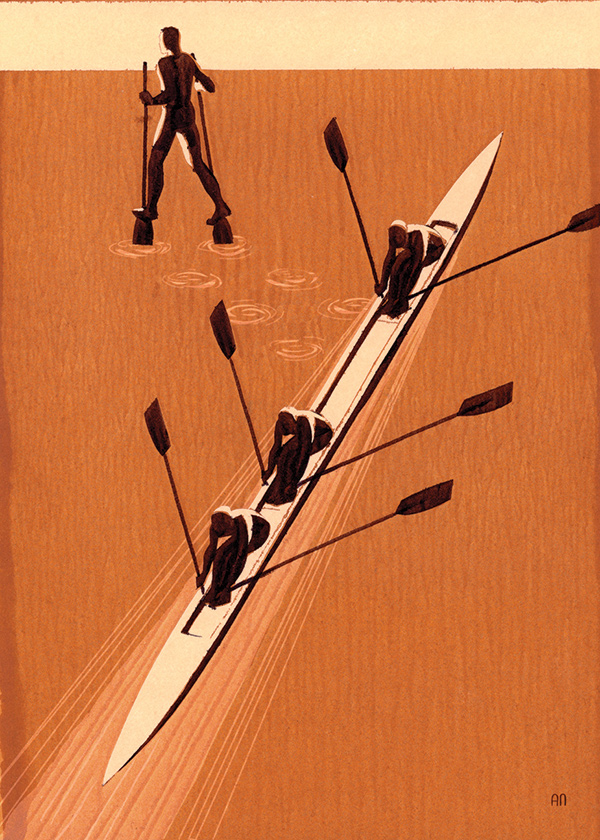The Iconoclastic Brain
From Steve Jobs to the Dixie Chicks, neuroscientist Gregory Berns explores what makes a rebel

Illustration by Alex Nabaum
Gregory Berns analyzes how people make decisions. So it shouldn’t have been a surprise when he asked me—during a recent interview—a polite version of “What are you doing here? This book has been out for three years.”
Despite the fact that the book in question is enormously interesting and remains worthy of review, returning an answer to Berns—Emory’s Distinguished Professor of Neuroeconomics, director of the Center for Neuropolicy, and professor in the Department of Economics—can feel a bit like sitting for a polygraph. He seems to see right through.
Which, come to think of it, is an uncommon virtue for a writer, and one that he makes the most of in his second book—Iconoclast: A Neuroscientist Reveals How to Think Differently. The premise is that “the iconoclast’s brain is different, and it is different in three distinct ways.” These three areas involve perception, fear response, and social intelligence.

Takes one to know one? Greg Berns suggests that the brains of iconoclasts are different from others in three key ways.
Bryan Meltz
Starting with perception, Berns argues that iconoclasts do see things differently, “because their brains do not fall into the efficiency traps as much as the average person’s brain.” Fear is the next stumbling block because, for most of us, novelty—on which the iconoclast must feed—triggers the fear system of the brain.
Any number of iconoclasts make it two-thirds of the way to the summit, but the tippy top is demonstrating social intelligence—in short, being able to bring one’s ideas to market. In Berns’s words, “[The] modern iconoclast navigates a dynamic social network and elicits change that begins with altered perceptions and ends with effecting change in other people (or dying a failure).”
Rare as iconoclasts are, Berns has populated a nearly 250-page book with them, and he has been catholic in his selection, featuring everyone from baseball manager Branch Rickey (one of his favorites) to Steve Jobs to the Dixie Chicks. He tried to see most of the living iconoclasts in person—except, of course, for the “famously secretive” Jobs. He didn’t succeed in every case, but he was determined to go beyond where existing biographies of these individuals would get him.
The overall lesson of the book is that most of us have a greater chance of winning the lottery than of ever achieving iconoclasm. As Berns notes, “If there is any message in my book, it is that if you want to go down the road of innovation or iconoclasm, it isn’t easy. Our brains are not evolved to be different from each other.”
Ah, but his is. Though reluctant to say so, Berns is an iconoclast when it comes to science. He sheepishly recalls coming home one day and telling his future wife that he was going to medical school, just like that—and just after finishing a demanding PhD program in bioengineering. She couldn’t see how the dots lined up. He couldn’t either, but he knew it was the right thing to do.
Berns doesn’t practice medicine anymore. He is, however, among Emory’s, and the nation’s, preeminent scientists. He is shrewd and businesslike, but he also is in it for the fun. You can hear it when he says, “I view the lab like a stock portfolio. I try to diversify by risk. The high-risk projects might completely fail and never be published, but they are the most exciting and fun to do.”
So what happens when an iconoclast writes a book about other iconoclasts? Having mastered social intelligence, Berns can communicate complex ideas with a colloquial touch, all the while displaying a vivid narrative style. His chapter on private space flight, for instance, begins:
The spaceships—more airplane than rocket really—sit majestically on the New Mexico tarmac. Diminutive by NASA standards and constructed of carbon composites to save weight, these craft look nothing like what the astronauts of yore rode into space and beyond. You can walk right up to these babies and run your hand over their bodies. You have no trouble standing on tiptoes and stroking the top of the fuselage, but duck down to inspect the wings because they hover about four feet from the ground. . . . These spaceships are as light and compact as a Cessna. But they possess a great deal more power than a light aircraft, and they do, of course, have a somewhat higher altitude rating—something beyond 300,000 feet. That’s 100 kilometers. Sixty-two miles. The edge of space.
Such description can stir excitement even for the same-brained majority of us who would find nudging the edge of space an exercise in abject terror.
The book ends in an interesting way, with an appendix that Berns calls “The Iconoclast’s Pharmacopoeia.” In essence, it is a list of drugs that—at least in theory—would enable iconoclasm in the rest of us. Though he has gotten some criticism for including it, Berns praises his publisher for allowing it to remain, indicating, “I felt strongly that [the appendix] needed to be included. At the end of the day, people want the easy answer, the easy way to creativity or innovation. There isn’t one.” In his view, the answer to many of our human shortcomings seems to be, “Isn’t there a pill I can take? That is a fair question,” he says, and the answer is, “Possibly, but realize the consequences.”
Borrowing from the Steve Jobs playbook, Berns won’t reveal his next book project, except to say that it “won’t be another book on the brain.” He complains that there are too many already. If Berns makes good on his promise, it will be disappointing in one sense, but it also will ensure the future appeal of this book. After all, it enshrines the courageous thinking and persistence of many “go-it-aloners,” a number of whom never squinted in the spotlight—such as Howard Armstrong (developer of the technologies that make radio and TV possible). And, for the rest of us, it makes our brains tingle just to imagine the possibilities.





